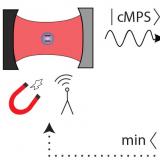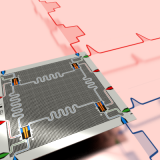Can you roll a basketball on the floor so that the ball comes back to the same position, but the orientation of its pattern has changed? Yes, you can, and after a few tries you will find out that the final orientation of the pattern is determined by the path traced by the ball on the floor. Quantum systems behave pretty much the same way: when subjected to a slowly varying external field, they acquire a phase that depends on the path they trace in their Hilbert space, that is, a geometric phase. In this work we have studied what happens when the external field is itself a quantum system, namely, a harmonic oscillator which can be populated with any number of photons. Instead of varying the state of the field, we prepare the field in a given state and slowly vary its coupling to the system. What we find is that a geometric phase is acquired even when the field is in the vacuum state, a result that has no semiclassical explanation but is correctly predicted by a full quantum theory. Our ability to control this phase opens new possibilities for the coherent manipulation of hybrid atom-cavity systems, with direct implications for quantum information processing. The results are published in Science Advances.

By employing a fully controlled cavity quantum electrodynamic system made of superconducting circuits, we experimentally create matrix product states, a class of states that has proven to be extremely powerful as a variational ansatz for numerical simulations. We create 1000 such quantum states and efficiently probe their correlation properties to determine an approximation to the ground state of a model describing a gas of interacting quantum particles. Having physical access to the simulated ground-state wave functions enables us to also probe higher-order correlation functions beyond measuring the ground-state energy. The experimental data are in good agreement with the exact solution over a wide range of interaction strengths of the model.

Quantum simulations are expected to vastly outperform classical simulations when modeling the dynamics of interacting spin systems. Researchers have used a digital quantum simulation to show that spin dynamics can be studied and predicted, which lays the groundwork for applications in quantum magnetism and strongly correlated systems.

We realized a two-spin "Gedankenexperiment" suggested by Dicke in 1954 using a system of two individually controllable superconducting qubits weakly coupled to a fast decaying microwave cavity. We demonstrate superradiance of two emitters both in time and by reconstructing the density matrix of the emitted field. The results of this work are published in Nature Communications.

We have implemented a scheme for generating single microwave photons with a tunable shape in superconducting circuits. The experiment describing the fully microwave-controlled shaping process is published in Phys. Rev. X .



